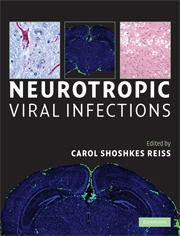Book contents
Section III - Introduction: immunity, diagnosis, vector, and beneficial uses of neurotropic viruses
Published online by Cambridge University Press: 22 August 2009
Summary
In this section, Chapters 14–23 cover a wider range of topics dealing with the viruses that cause disease in the central nervous system (CNS). The first three chapters in the final section concern aspects of the immune response. The next three are about detection and treatment of infections and about the insects and animals that transmit the viruses to people. The final chapters focus on neurotropic viruses for gene transfers and for elimination of a brain tumor.
General principles of innate immunity, with special attention to the specific problems of infections in the brain, are covered in three chapters. The first describes important and often overlooked pathways that regulate innate immune responses and control virus infections (Chapter 14). The importance of lipid mediators and alternative pathways of inflammation, as well as the ways drugs may influence them, are described.
Then Chapter 15 highlights the Toll-like receptor pathway and other intracellular inflammatory pathways that are critical in the elicitation of the initial type I interferon response. This response is both antiviral and bridges innate and adaptive immunity.
The influence of the neuroendocrine networks on immune responses to viral infections is detailed in the following chapter (Chapter 16). It has long been recognized that the fight-or-flight response and stress have profound influences on both acute and persistent immune responses during infections.
Public health personnel rely heavily on the data associated with epidemiology as well as clinical signs to direct their diagnostic analyses when presented with a sick patient.
- Type
- Chapter
- Information
- Neurotropic Viral Infections , pp. 263 - 264Publisher: Cambridge University PressPrint publication year: 2008



